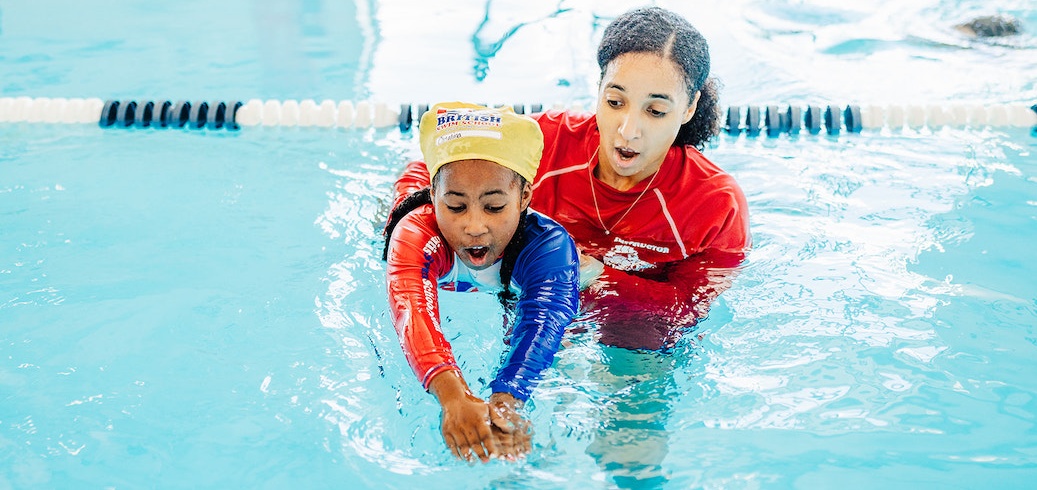The British Swim School Guide to Proper Technique and Stroke Development
Swimming is more than simply a recreational activity – it’s a life-saving skill, both an individual and team sport, as well as a fantastic form of exercise. There are 4 technical swimming strokes that are most commonly used in recreation and competition; freestyle, backstroke, breaststroke, and butterfly. Each stroke has its own unique set of movements and breathing patterns, making them suitable for different individuals based on personal preferences, fitness levels, and goals.
Let’s explore the proper technique for each stroke, the importance of mastering them, and then we’ll provide valuable tips to help you improve your swimming strokes.
Freestyle
Freestyle is the fastest and most common stroke used in swimming. To perform it correctly, focus on the following key elements:
- Arm movement: Reach forward with one arm, pulling it down and then pushing through the water at the hips, while the other arm breaks the surface, then re-enters and repeats. Keep your elbows high and fingers together to reduce resistance.
- Kicking technique: Using a flutter kick, keep your legs relaxed and relatively straight while moving them up and down. This action comes from the hips – not the knees (although the knees and ankles should be “relaxed”).
- Body rotation: Slightly “slice through the water” by leaning into each pull to maximize your reach and reduce strain on your shoulders. This reduces the amount of resistance the body fights against the water, and looks like a slight roll.
- Breathing: Slightly roll onto the side of the extended arm while the other is beginning the pull under the water, turn your head to the side, inhale, and turn the head back into the water. Exhale through your nose and mouth when your face is submerged in the water.
Breaststroke
The breaststroke is often referred to as a “survival stroke”, as it’s one of the least strenuous, but can be fairly complicated to learn at first. For a successful breaststroke:
- Arm and leg movements: Start with your arms extended forward and pull them back in a circular motion to your chest, while your legs kick out and around, then snap together. Glide after each kick and arm pull.
- Timing: Coordinate your arm pull with your leg kick to maintain a smooth rhythm, with the kicks starting just after beginning the pull. Each “snap” should happen when the arms extend outwards so the body is in a “streamlined” position during the glide.
- Breathing: As the arms begin to pull towards the chest, the momentum helps to “pop” the head up to take a breath, then the head re-enters the water. Exhale while your face is in the water during the glide phase.
- Body positioning: Keep your body level in the water, with your head aligned with your spine.
Backstroke
The backstroke is swum on the back and offers an excellent opportunity to breathe freely while swimming. Master the following aspects of the backstroke:
- Arm and leg movements: Your arms should move in an alternating motion where one arm reaches straight out behind the head, enters the water, and pushes the hand underneath towards the hips, while the other arm lifts out straight. Think “thumb out, pinky in”.
- Body rotation: Roll your body slightly from side to side with each arm stroke to maintain a steady rhythm, similar to the same motion mentioned in freestyle.
- Breathing: Breath continuously with the head in a neutral position and the chin tilted up.
- Body positioning: Keep your body flat on the water’s surface, ensuring your head remains straight and aligned with your spine.
Butterfly
The butterfly stroke is one of the more challenging yet elegant swimming strokes when performed well. It requires strength and coordination to execute properly:
- Arm movements: Sweep both arms simultaneously over your head and pull them down in a semicircular motion, propelling your body forward.
- Dolphin kick: Perform a powerful kick with both legs, keeping them together throughout the movement. This movement begins from the core.
- Timing: Each “stroke” should include two dolphin kicks and one pull, in a rhythmic sequence.
- Breathing: Take a breath in as the body is lifted out of the water during the recovery phase, then exhale through the nose while your face is submerged. Try to avoid lifting the head to breathe, as this affects the body’s correct alignment.
Find Swimming Lessons Near Me ➝

Choosing the Right Swimming Strokes for You
When deciding which stroke to learn, consider factors such as your preferences, fitness level, and goal. Each stroke offers unique benefits:
- Freestyle: Ideal for building endurance and speed, making it a popular choice for competitive swimmers.
- Breaststroke: This has the potential to be a style of swimming that has less impact on the body once learned correctly. Also is a great stroke to learn for safety as it conserves energy and allows for the head to be out of the water, and arms to stay in the water, which can be beneficial to water survival scenarios.
- Backstroke: Perfect for those who prefer to swim on their back and enjoy the freedom to breathe easily.
- Butterfly: A challenging stroke that targets the entire body, suitable for experienced swimmers seeking a full-body workout.
Common Mistakes to Avoid
Learning any new skill comes with its challenges, and swimming is no exception. Some common mistakes to watch out for include poor technique and body positioning:
- Freestyle: Avoid crossing your arms over or making wide sweeping motions, as it can slow you down.
- Breaststroke: Steer clear of bringing your arms back too early during the kick phase, which can disrupt your momentum.
- Backstroke: Be cautious not to let your hips sink, as it can slow down your progress and increase drag.
- Butterfly: Resist the temptation to rush your arm and leg movements, as it can throw off your rhythm.
To avoid these mistakes, consider taking swimming lessons with British Swim School – we provide personalized guidance and feedback on your form!
Tips for Improving Your Swimming Strokes
Improving swimming strokes requires consistent practice and dedication. Incorporate the following tips into your routine to enhance your skills:
- Practice drills: Focus on specific aspects of each stroke with targeted drills to isolate and improve individual movements.
- Video analysis: Record yourself swimming and review the footage to identify areas that need improvement.
- Consistency: Regular practice is key to becoming a proficient swimmer. Set aside dedicated time for swimming workouts each week.
- Seek feedback: Request feedback from experienced swimmers or instructors to gain insights into areas that need improvement.
Find Swimming Lessons Near Me ➝

Sign Up for Swim Lessons & Improve Your Swimming Strokes Today
Swimming lessons are a safe and enjoyable activity that can help your child stay active, make new friends, and build their confidence. Plus, they teach essential life skills that can save lives in an emergency.
At British Swim School, our program starts with gentle water acclimation and survival techniques before moving on to stroke development. By focusing on water safety, you’ll gain the skills necessary to survive an emergency situation in the water.
Our swim classes are available year-round throughout the US and Canada, with small group swim lessons to ensure each swimmer receives personalized attention and instruction. Our professional instructors are passionate about swimming and will inspire and motivate you throughout your learning journey. You’ll soon understand what sets us apart as a leading swim school!
We offer programs for all ages and abilities, from babies as young as 3 months, through infants, toddlers, older kids, and adults. Don’t wait any longer to give yourself or your child the gift of water safety. Enroll in our swim school today and start learning to stay safe in the water for life!






